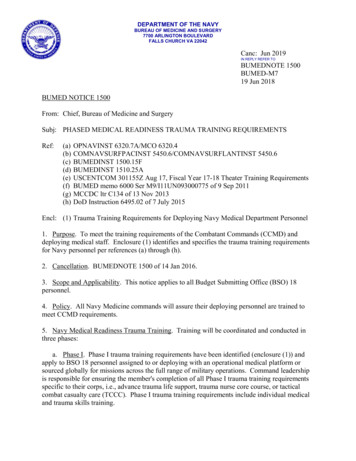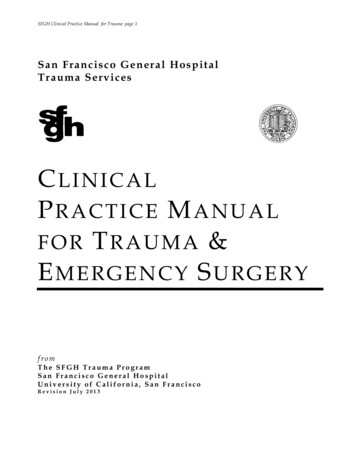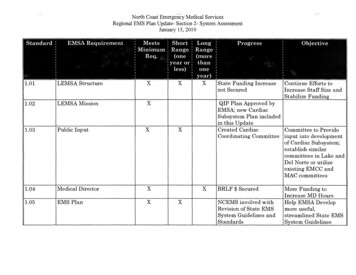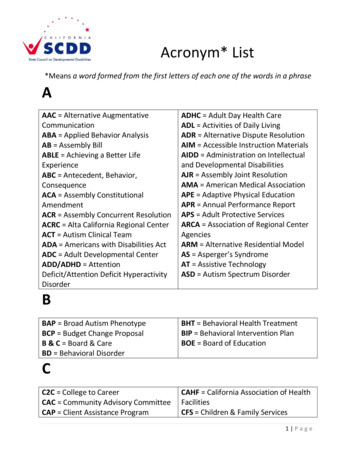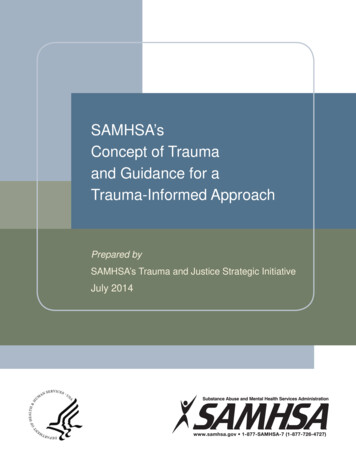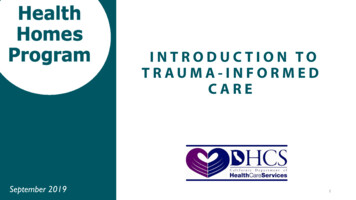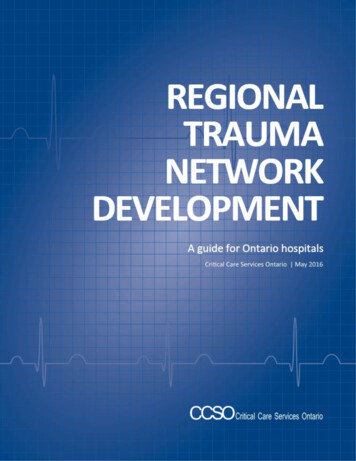
Transcription
REGIONALTRAUMANETWORKDEVELOPMENTA guide for Ontario hospitalsCritical Care Services Ontario May 2016
This document is a product ofCritical Care Services Ontario (CCSO).The Regional Trauma Network Development Guide outlines steps to develop regionaltrauma networks (RTNs) in Ontario. The approach is based on identified best practicesand the experiences of pilot RTNs in the Champlain and Central South Ontario regions.i
For information about this document, please contact:Critical Care Services OntarioPhone: 416-340-4800 x 5577Email: ccsadmin@uhn.caWebsite: www.criticalcareontario.caCCSO is funded by the Government of Ontario.ii
Version ControlName of documentRegional Trauma Network Development GuideVersion1.0CreatedMay 2016Suggested next reviewApril 2017iii
Table of Contents1. HOW TO USE THIS DOCUMENT . 41.1 Purpose . 41.2 Structure . 42. ONTARIO TRAUMA SYSTEM BACKGROUND . 52.1 Critical Care Services Ontario . 52.2 Ontario Trauma Advisory Committee . 52.3 Toward an inclusive trauma system . 52.4 Lead Trauma Hospitals in Ontario. 72.5 RTN pilots in Ontario . 73. GOALS. 103.1 Regional trauma network objectives . 103.2 Performance indicators. 104. STAKEHOLDERS . 135. IMPLEMENTATION GUIDE . 145.1 Phase I: Initiation . 151. Establish RTN Steering Committee . 152. Confirm catchment area . 163. Gather information . 164. Develop engagement strategy . 185. Determine trauma levels of care . 196. Hold inaugural meeting. 205.2 Phase II: Priority setting . 211. Identify regional areas of focus. 212. Prioritize areas of focus. 213. Establish working groups . 224. Coordinate RTN progress meetings . 225.3 Phase III: Maintenance . 231. Share knowledge through outreach and education . 232. Measure and report performance . 243. Learn from experience . 242
4. Incorporate evolving considerations . 24REFERENCES . 26APPENDICES . 28Appendix A: Regional trauma networks – concept and history . 28Appendix B: Ontario RTN Map . 32Appendix C: Communications Package . 33Appendix D: Terms of Reference for Regional Trauma Networks . 36Appendix E: Sample Memorandum of Understanding for Level 3 trauma care. 38Appendix F: Sample questionnaire to identify regional areas of concern . 39Appendix G: Work Planning Resources . 40Appendix H: Trauma Centre Consultation Guidelines . 41INDEX . 423
1. HOW TO USE THIS DOCUMENTThis document was compiled by Critical Care Services Ontario. It synthesizes numerous sources ofinformation on trauma systems and, in particular, regional trauma network models, into a user-friendlyeasy-reference format. It should be used as a guide to develop regional trauma networks in Ontario andto begin to establish a quality-assurance process for trauma-care improvement locally, regionally, andprovincially.The trauma-system model is based upon public health models of trauma systems operating in Europe,North America, and Australia. These have proven efficacy in reducing death and disability from severeinjury.1.1 PurposeThe aim of this document is to provide information on trauma and trauma systems, and present apractical and evidence-based model suitable for developing regional trauma networks in Ontario. Itstarget audience includes, but is not limited to, hospital administrators, medical directors, administrativeleads and trauma coordinators at Lead Trauma Hospitals and referring hospitals, transport providers andCritiCall Ontario.1.2 StructureThis document contains five sections, which users may read sequentially or as stand-alone sections.1. How to use this document (this section)2. Background3. Goals and performance measurement4. Stakeholders5. Implementation guideReferencesBackground information on the Ontario traumacare system and the evidence for developingregional trauma networksThe objectives of an inclusive trauma system andof regional trauma networks, and data and metricsto gauge progressStakeholders and how they can contribute to thedevelopment of a regional trauma networkRecommended activities for phased developmentof regional trauma networksA selection of peer-reviewed journal articles andother publicationsAppendicesIndex4
2. ONTARIO TRAUMA SYSTEM BACKGROUND2.1 Critical Care Services OntarioCritical Care Services Ontario (CCSO) is the managing body responsible for the overall programimplementation of initiatives of the Critical Care Strategy and the Ontario Critical Care Plan 2015-2018.Originally established as the Critical Care Secretariat in June 2005, its work is the result of an on-goingcollaboration between critical care health care providers, hospital administrators, officials from theMinistry of Health and Long-Term Care, Emergency Medical Services, Local Health Integration Networksand other health system partners.CCSO’s mission is to lead the overall planning, implementation and evaluation of critical care services(including trauma, burns, neurosurgery, pediatric critical care) for the Province of Ontario through thevision of an accessible, integrated system of evidenced-based critical care services for Ontarians.2.2 Ontario Trauma Advisory CommitteeExpertise from stakeholder group representatives is crucial to the success of CCSO’s initiatives. TheOntario Trauma Advisory Committee (OTAC) endeavors to guide a world-class trauma system, focusingon reducing death and disability related to injury. OTAC works collaboratively and transparently toensure a quality-based trauma system that decreases the incidence and severity of trauma; ensuresoptimal, equitable, accessible, patient-centred care for Ontarians sustaining injuries; implements qualityand performance improvement activities; ensures that designated facilities have appropriate resourcesto meet the needs of the injured; and provides appropriate rehabilitation and support services.To support the initiatives of the OTAC, several sub-committees have been established to provideguidance and focus to various aspects of the trauma program. The OTAC Performance ImprovementSub-Committee provides a forum to identify a standardized set of performance metrics for all LeadTrauma Hospitals, regional trauma systems and a province-wide trauma system. In March 2014, thePerformance Improvement Sub-Committee launched a Performance Improvement Indicator Report withkey metrics in the areas of access, quality and system integration. Quarterly and annual performanceresults reports are sent to key stakeholders at all levels monitor and improve performance across thesystem.2.3 Toward an inclusive trauma systemIt is essential to deliver the ‘right care’ at the ‘right time’ in the ‘right setting’ by the ’right healthcareprovider’ in order to achieve the best possible health outcomes for injured patients. An inclusive traumasystem leverages the capacity and capability among all providers that may be involved in the care of aninjured patient. In Ontario, we can only achieve an inclusive trauma system when all parts of the traumacare system are organized, connected, and working collaboratively with other healthcare partners todevelop a fully integrated system.5
This approach aligns with priorities in Ontario’s Patients First: Action Plan for Health Care, especially interms of improving access (providing patients with faster access to the right care), and protecting ouruniversal health care system (making decisions based on value and quality, to sustain the system forgenerations to come) by, for example, implementing more innovative approaches based on evidence.With repatriation initiatives associated with RTNs, there is also alignment to the principle of connectingservices (delivering better coordinated and integrated care in the community, closer to home).It is vital that an inclusive trauma system consider overarching strategies to assist in the implementationand sustainability of key priorities. A governance model that is comprehensive and transparent shouldclearly outline accountabilities for all Lead Trauma Hospitals and referring hospitals with agreed-uponbest practices and principles.Figure 1 below summarizes the structure and objectives of an inclusive trauma system in Ontario.Where do we want to be?Support a system of sharedaccountability amongst regionalhospitalsCreate an inclusive trauma systemto improve the delivery of care toinjured patientsEngage clinicians and administratorsacross the province to advance bestpracticesLeverage leadership from leadtrauma hospitals to implementsystem improvementsLead Trauma Hospitals act asregional “hubs” to communicatewith referring hospitals (“spokes”)their catchment areaPromote health human resourcesand skills developmentFigure 1: Toward an inclusive trauma system in Ontario[Source: Lawless (2015), presentation at Trauma Association of Canada conference]6
2.4 Lead Trauma Hospitals in OntarioIn the early 1990s, the Ministry of Health and Long Term Care designated eleven (11) hospitals as LeadTrauma Hospitals (LTHs) to provide coordinated trauma services across the province. Regional traumanetworks (RTNs) will be established based on Ontario’s LTH sites. These hospitals, listed below, arelocated across Ontario and serve to provide leadership and coordinated specialized care to moderatelyand severely injured patients.Lead Trauma Hospital1. Windsor Regional HospitalLocationWindsorLHINErie St. Clair (LHIN 1)2.London Health Sciences CentreLondonSouth West (LHIN 2)3.Hamilton Health Sciences (RTN pilot site)Hamilton4.The Hospital for Sick ChildrenTorontoHamilton Niagara HaldimandBrant (LHIN 4)Toronto Central (LHIN 7)5.St. Michael’s HospitalTorontoToronto Central (LHIN 7)6.Sunnybrook Health Sciences CentreTorontoToronto Central (LHIN 7)7.Kingston General HospitalKingstonSouth East (LHIN 10)8.Children’s Hospital of Eastern OntarioOttawaChamplain (LHIN 11)9.The Ottawa Hospital (RTN pilot site)OttawaChamplain (LHIN 11)10. Health Sciences NorthSudburyNorth East (LHIN 13)11. Thunder Bay Regional Health Sciences CentreThunder BayNorth West (LHIN 14)Table 1: Lead Trauma Hospitals in Ontario2.5 RTN pilots in OntarioIn 2013, as part of its regional system development work to improve system integration, CCSO incollaboration with OTAC, established an advisory committee to develop a framework of key componentsfor implementing a RTN. From this work, CCSO collaborated with 2 LTHs to implement two pilot RTNs:Champlain and Central South. The Champlain RTN covers LHIN 1 (Champlain); the Central South RTNencompasses LHIN 3 (Waterloo Wellington), LHIN 4 (Hamilton Niagara Haldimand Brant), and the Haltonportion of LHIN 6 (Mississauga Halton).These networks use a hub-and-spoke model with the LTHs working in partnership with their referringhospitals and transport providers to improve patient access to an appropriate level of care. The aim ofthe RTNs is to assist in improving communication, standardizing referral and repatriation practices, andimproving trauma service delivery throughout the province.7
The timeline in Figure 2 below summarizes the activities undertaken over the past two and a half yearsleading up to and including piloting an RTN model in Ontario:FOUNDATION-BUILDINGRTN PILOT PROJECTDeveloped model forinclusive traumasystem for OntarioSelected 2 LTHsto runpilot RTNsSpring 2013Fall 2013PROCESS EVALUATIONConducted processevaluation of pilotRTNsFall 2015Summer 2013Winter 2013 – Fall 2015EstablishedAdvisory Panelon RegionalSystemDevelopmentDevelopedpilot RTNsFigure 2: Ontario regional trauma network pilot initiative2.5.1 Bespoke approachEach pilot RTN used the framework developed by the Advisory Committee to guide its implementationefforts. As implementation progressed, key areas of focus for each RTN emerged. The framework wasflexible to allow each RTN to focus its work on the areas of priority in its region. In both pilots, thecomposition of the RTN reflected natural referral patterns and partnerships. The local circumstances,such as the geography and proximity of referring hospitals to LTH and the complexity of existing LHINrelationships and cross-LHIN collaboration, determined whether the pilot RTN membership wascomprehensive or selective. One of the most important differences between the two pilots was that TheOttawa Hospital catchment area encompasses one LHIN whereas the Hamilton Health Sciencescatchment area encompasses three LHINs. For a detailed comparison of the experiences of the two pilotRTNs, see the slide deck ‘A Tale of Two Pilots: Ottawa and Hamilton’ which was presented at 2015annual conference of the Trauma Association of Canada. The slide deck is available ages/default.aspx.2.5.2 Process evaluationIn October 2015, CCSO conducted a process evaluation of the experiences of the two pilot RTNs anddrew the following findings:1. The implementation plan should be simple and clear to all stakeholders. It is crucial to havewidespread consensus about the plan’s value among all stakeholders.8
2. The chances of success are likely to be increased by strong leadership and active engagement ofa broad range of implementers.3. Membership should be based on referral patterns between and among the hospitals. For theRTN team to be effective, team representation should include both an administrator and aclinical representative from each hospital.4. The implementation plan should be flexible and adaptable to the local situation. The plan shouldbe open to include both opportunities to learn through action and a way to share lessons ofexperience in improving the ongoing implementation of the program. A phased scaling-up of theprogram provides opportunities to learn.Based on these findings, CCSO will guide the establishment of RTNs in the remainder of Ontariothroughout the 2016-2017 fiscal year.9
3. GOALS3.1 Regional trauma network objectivesThe overall goal of a regional trauma system is to reduce death and disability following major trauma,which encompasses the following supplemental goals (Kaufmann, 2015): Decrease the incidence and severity of traumaEnsure optimal, equitable, and accessible care for all persons sustaining traumaPrevent unnecessary deaths and disabilities from traumaContain costs while enhancing efficiencyImplement performance improvement of trauma care throughout the system (benchmarking)Ensure awareness of all facilities with appropriate resources to meet the needs of the injured andthat all facilities participate commensurate with their capabilities3.2 Performance indicatorsData collection and reporting of performance indicators can assess whether the trauma system and itscomponent sub-systems are achieving their goals. Performance monitoring can also identify areas forimprovement.3.2.1 Types of indicatorsIndicators can span the patient care continuum, from injury prevention to critical care to recovery, andcan be monitored at various levels of the trauma system, as shown in Figure 3 below.Figure 3: Types of indicators in a trauma system[Source: Gruen et al. (2011)]10
Across the phases of care along the continuum, indicators can assess structure, process, and outcomemeasures, as shown in the model in Table 2 below.Table 2: Conceptual model of performance measures in trauma care[Source: Gruen et al. (2011)]3.2.2 Proposed indicators for OntarioWithin the context of Ontario’s trauma system, a comprehensive range of RTN effectiveness measuresfor trauma response, acute care, and post-trauma recovery care has been identified (Caro, 1997).However, the accessibility of data across these sectors can sometimes be a limiting factor to developinga complete description of the current state of access to trauma care in Ontario. In the interim, thefollowing three (3) indicators are preliminary measures that can be used to reflect RTN effectiveness inOntario:(i) Referring hospital time-to-transferThis performance indicator tracks the time between when a patient arrives at a referring hospital andwhen the patient departs that hospital to be transferred to a LTH, as illustrated in Figure 4 below. InOntario, this indicator is currently included as part of the provincial trauma scorecard. The Central Southpilot RTN has been examining the use of this indicator as an RTN effectiveness measure.Figure 4: Referring hospital time-to-transfer performance indicator11
(ii) Patient arrival to trauma team leader response time to bedsideThe ‘patient arrival to trauma team leader response time to bedside’ indicator measures the timebetween when a patient arrives at an LTH and the arrival of the Trauma Team Leader to the patient’sbedside. This indicator is also currently included as part of the Ontario trauma scorecard. ThePerformance Improvement sub-committee of OTAC reviewed this indicator in 2015-2016 to confirmcurrent data collection methodology and to update the user guide to improve clarity.(iii) Risk-adjusted mortality rateThe risk-adjusted mortality rate compares an LTH’s in-patient mortality rate to the expected mortalityrate, given specified risk factors in the patient population. A working group reporting to thePerformance Improvement sub-committee of OTAC developed the methodology and definition for thisindicator in 2015-2016 to report differences in mortality rates across trauma centres in Ontario.Trauma Distinction programHospitals interested in attaining Trauma Distinction status should also consider the AccreditationCanada indicators, which are described in detail in the Trauma Distinction Information Package,available at: -distinction-info-en.pdf.The program specifies performance thresholds for seven (7) core performance indicators:1.2.3.4.5.6.7.Field triageWait time for rehabilitationTrauma team activationEmergency department length of stayLength of stay in acute careComplications during hospital stayTrauma mortalityThe program also lists nine (9) additional optional indicators, of which two (2) are required to becollected and submitted to attain and maintain Trauma Distinction status.12
4. STAKEHOLDERSThere are several stakeholders in a regional trauma network. The following table summarizes thestakeholder organizations and identifies their respective contributions.Stakeholder organizationLTHContributionImplementation leadership; governance; decision-making; subject matterexpertise; ensuring alignment along patient care continuum in an inclusivetrauma systemReferring hospitalsCritiCall OntarioGovernance; decision-making; subject matter expertise; implementationSubject matter expertise, ensuring alignment in an inclusive trauma system;tracking system dataSubject matter expertise; ensuring alignment in an inclusive trauma systemSubject matter expertise; ensuring alignment in an inclusive trauma systemSubject matter expertise; ensuring alignment in an inclusive trauma systemSubject matter expertise; ensuring alignment in an inclusive trauma systemEndorsement, governance, alignment within and across LHINsSystem-level strategy and direction; link to provincial tableCentral coordinating body, facilitation, research, policy guidance, supportStrategic direction and provincial priorities; legislation, regulations, standards,policies, and directives; planning and guiding resourcesPatient and caregiver voiceEMSOrngeRehabilitationPaediatric trauma careLHINOTACCCSOMOHLTCPatients and familiesFigure 5 below depicts the stakeholder organizations within the RTN, as well as those that influence theRTN from a system-level perspective.Figure 5: Regional trauma network stakeholders13
5. IMPLEMENTATION GUIDEA consistent theme in the RTN pilots’ experience and the literature review is ‘one size does not fit all’and, therefore, it is crucial to be cognizant of local circumstances and to determine local priorities. Thiswas also a key finding of the process evaluation of the pilot RTNs. Therefore, instead of stipulatingprescriptive implementation rules, this document provides high-level implementation guidelines thatRTNs could tailor to their specific needs.A good example of detailed implementation considerations can be found in a 2010 report by the UnitedKingdom’s National Health Service (NHS) Clinical Advisory Groups, available ages/Toolkits.aspx.We recommend the following phased approach, to provide opportunities for learning and growth.2016-2017Q1-Q32016-2017Q3, Q4Phase I:Phase II:InitiationPriority-setting Establish RTN SteeringCommittee Confirm catchment area Gather information Develop engagementstrategy Determine levels of traumacare Hold inaugural meeting Identify regional issues Prioritize issues Establish working groups Coordinate RTN progressmeetings142017-2018Q1-Q4Phase III:Maintenance Share knowledge throughoutreach and education Measure and reportperformance Learn from experience Incorporate evolvingconsiderations
5.1 Phase I: InitiationThe first phase in developing an RTN is the initiation phase, in which there are six (6) main activities, asdescribed below. This phase should last approximately six to nine months. For the development of newRTNs in Ontario, we expect this period to run from April to December 2016.1. Establish RTN Steering CommitteeAs a starting point, each LTH should identify representatives from varying areas of expertise to form acommittee to lead the development of the RTN in its catchment area. The composition of such acommittee may vary across regions depending on local circumstances; however, it is recommended thatan RTN Steering Committee should consist of: Two co-leads, as follows:o Administrative co-lead:This person should be a senior executive at the LTH, with the authority to make, oreffectively facilitate, decisions for the hospital(e.g., President and CEO; or Senior VP, Clinical Programs; or Senior VP, Medical Affairs,Quality and Performance);o Clinical co-lead:This person should have an in-depth understanding of the trauma operations at the LTH,from a clinical perspective(e.g., Trauma Medical Director);AND15
Members from among the following suggested roles, or other roles as appropriate for the LTH:o Trauma coordinatoro Critical care lead LHINo Trauma services directoro ED LHIN representativeo Injury prevention representativeo Emergency department leado Burns program representativeo Emergency department physiciano Paediatric surgery program representativeo Advanced practice nurseo Rehabilitation program representativeo Nurse managero Clinical Director, Surgery Programo Residento Trauma surgeono Patients and familiesThe members of your RTN Steering Committee would be responsible for leading the development of theRTN within your catchment area and guiding system improvement initiatives in partnership with yourreferring hospitals and transport providers to improve patient access to an appropriate level of care.2. Confirm catchment areaCCSO has worked with CritiCall Ontario to review referral patterns and propose catchment areas, asdepicted in the Ontario RTNs map in Appendix B. CCSO will provide each LTH with its proposedcatchment area, based on current referral patterns. One of the key findings from the process evaluationof the pilot RTNs was that membership should be based on referral patterns.The LTHs should review their proposed catchment areas and confirm that it accurately captures itsreferring hospitals. To facilitate this process, LTHs may consult CritiCall Ontario’s Provincial HospitalResource System (PHRS), which contains information on the specific services that each hospital providesand the availability of critical and acute care beds. In addition, LTHs may opt to review volumes todetermine referring hospital representation within their RTN.3. Gather informationEach LTH should gather data about the stakeholder organizations in its catchment area prior toimplementation of the RTN model. This step allows the LTH to assess the current status and to identifyareas that may require attention.LTHs may use the checklist provided on the following page to conduct this activity.16
TOOL: Pre-implementation information gathering checklistPRE-IMPLEMENTATION INFORMATION GATHERING CHECKLISTTrauma System ComponentRTN partnership/goal settingInformation to gather Trauma care facilitiesTriage, transport anddestination Inter-hospital/facility transfers Public information, education& prevention Data collection and traumasystem evaluation Human resources What are the objectives for each organization within the RTN?Each organization’s goal should demonstrate how theorganization will contribute to the development an inclusivetrauma system.What are the relationships between and among all of thehealthcare partners in the RTN? An organization chart can be auseful visual depiction.Which hospitals are within the catchment area for the RTN? Whatis the capability of each hospital to manage injured patients?What would the trauma level designation be for each hospital?What should be the roles and responsibilities of each hospital?What are the services provided by each hospital?What field triage/ trauma guidelines and procedures will be usedwithin the RTN? How will they incorporate CCSO/CritiCall’sTrauma Centre Consultation Guidelines (Appendix H)?How will EMS systems ensure availability of EMS resources duringperiods of minimum staff availability, high transfer volumes, highcall volumes, etc.?What air ambulance services are there within the catchment areafor the RTN? What protocols, if any, are there?What inter-facility transfer agreements, if any, are there betweenLead Trauma Hospitals and referring hospitals within the RTN?What injury prevention initiatives are there?Which organizations are involved in injury prevention?What opportunities are there for patient and family engagement?What trauma data can be used to measure perf
8. hildren [s Hospital of Eastern Ontario Ottawa Champlain (LHIN 11) 9. The Ottawa Hospital (RTN pilot site) Ottawa Champlain (LHIN 11) 10. Health Sciences North Sudbury North East (LHIN 13) 11. Thunder Bay Regional Health Sciences Centre Thunder Bay North West (LHIN 14) Table 1: Lead Trauma Hospitals in Ontario 2.5 RTN pilots in Ontario


